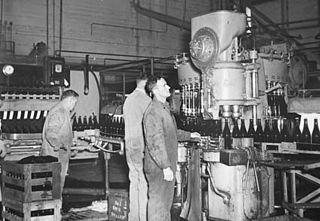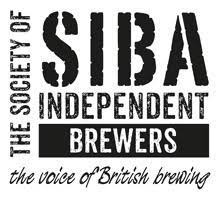
The Campaign for Real Ale (CAMRA) is an independent voluntary consumer organisation headquartered in St Albans, which promotes real ale, cider and perry and traditional British pubs and clubs.

Mild ale is a type of ale. Modern milds are mostly dark-coloured, with an alcohol by volume (ABV) of 3% to 3.6%, although there are lighter-hued as well as stronger milds, reaching 6% abv and higher. Mild originated in Britain in the 17th century or earlier, and originally meant a young ale, as opposed to a "stale" aged or old ale.

A pub is in several countries a drinking establishment licensed to serve alcoholic drinks for consumption on the premises. The term first appeared in England in the late 17th century, to differentiate private houses from those open to the public as alehouses, taverns and inns. Today, there is no strict definition, but the Campaign for Real Ale (CAMRA) states a pub has four characteristics:
- is open to the public without membership or residency
- serves draught beer or cider without requiring food be consumed
- has at least one indoor area not laid out for meals
- allows drinks to be bought at a bar

Craft beer is beer manufactured by craft breweries, which typically produce smaller amounts of beer than larger "macro" breweries and are often independently owned. Such breweries are generally perceived and marketed as emphasising enthusiasm, new flavours, and varied brewing techniques.

India pale ale (IPA) is a hoppy beer style within the broader category of pale ale.

Bitter is an English style of pale ale that varies in colour from gold to dark amber, and in strength typically from 3% to 5.5% alcohol by volume.

The Independent Family Brewers of Britain (IFBB) was formed in the 1993 by an informal group of family-owned/controlled brewery CEOs known as the Pimlico Group - all of whom were part of the UK's Brewers Society, now the British Beer and Pub Association.

Beer has been brewed in England for thousands of years. As a beer brewing country, it is known for top fermented cask beer which finishes maturing in the cellar of the pub rather than at the brewery and is served with only natural carbonation.

Beer arrived in Australia at the beginning of British colonisation. In 2004 Australia was ranked fourth internationally in per capita beer consumption, at around 110 litres per year; although, the nation ranked considerably lower in a World Health Organization report of alcohol consumption per capita of 12.2 litres. Lager is by far the most popular type of beer consumed in Australia.

Brewing in Ireland has a long history. Production currently stands at over 8 million hectolitres, and approximately half the alcohol consumed is beer.

The Society of Independent Brewers is an organisation representing the interests of independent breweries in the UK. Founded in 1980, it was intended to fight the pub-tie system, under which large brewers owned 80% of the UK's pubs. It changed its name in 1995 to reflect the changing aspirations of its members, but retained its original acronym.

Beer is the most popular alcoholic drink in New Zealand, accounting for 63% of available alcohol for sale. At around 64.7 litres per person per annum, New Zealand is ranked 27th in global beer consumption per capita. The vast majority of beer produced in New Zealand is a type of lager, either pale or amber in colour, and typically 4–5% alcohol by volume.

"A Pub with No Beer" is the title of a humorous country song made famous by country singers Slim Dusty and Bobbejaan Schoepen.

Beer in the United Kingdom has a long history, and has quite distinct traditions. Historically the main styles were top-fermented Bitters, Porters, Stouts and Milds, but after World War II lagers took over half the market by volume. The Campaign for Real Ale (CAMRA) was founded in 1971 and has encouraged the preservation and revival of traditional styles of ale. In particular CAMRA has promoted cask conditioned beer, which completes its maturation in casks in the cellar of the pub rather than at the brewery. As of 2014 the UK drank 634 million imperial pints of cask ale, representing 60% of ale in pubs and restaurants and 17% of all beer in pubs. In total 42.42 million hectolitres of beer were produced in 2013 of which 48% was sold in the off-trade.

The U.S. state of Vermont is home to over 100 breweries, microbreweries, nanobreweries, and brewpubs that produce a wide variety of beer.

Beer in Scotland is mostly produced by breweries in the central Lowlands, which also contain the main centres of population. Edinburgh and Alloa in particular became noted for the export of beer around the world in the 19th century.
Central City Brewers & Distillers is a Canadian brewery in Surrey, British Columbia, Canada. In 2010, their Thor's Hammer won silver in the Barley Wine-Style Ale category of the World Beer Cup awards. They released their Red Racer Low Rider Raspberry on September 25, 2017.
Beer Day Britain is an annual event celebrating beer in the United Kingdom. The date has been celebrated annually on 15 June since 2015. It is supported by the British Beer and Pub Association, the Society of Independent Brewers (SIBA), and the Campaign for Real Ale (CAMRA).

Horse Brass Pub is a British-style pub in Portland, Oregon, in the United States. Established in 1976, the bar and restaurant serves British cuisine and has approximately 50 beers on tap.

The Ram Inn is a historic pub at 68 Wandsworth High Street, Wandsworth, London SW18.


















